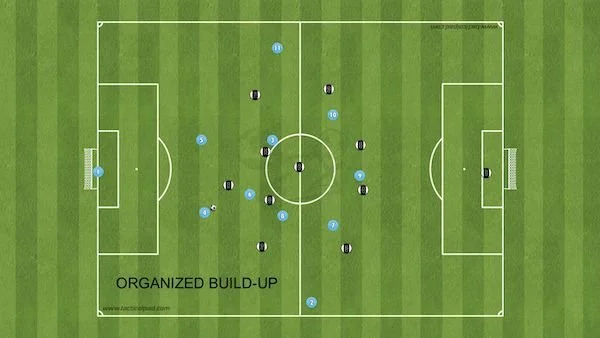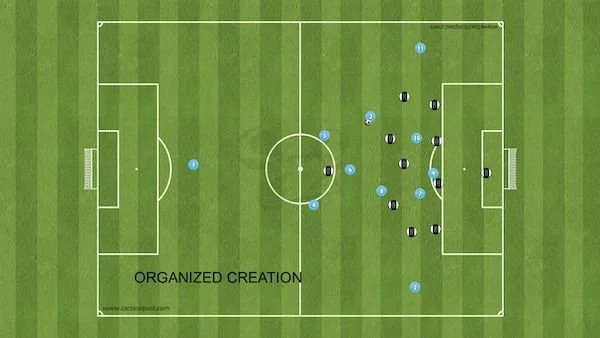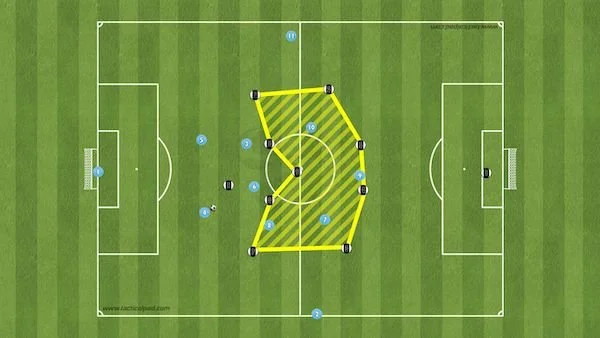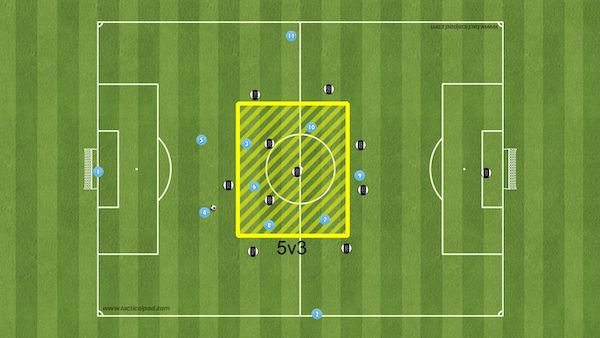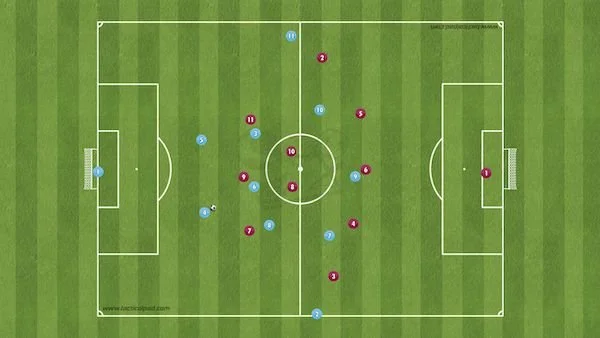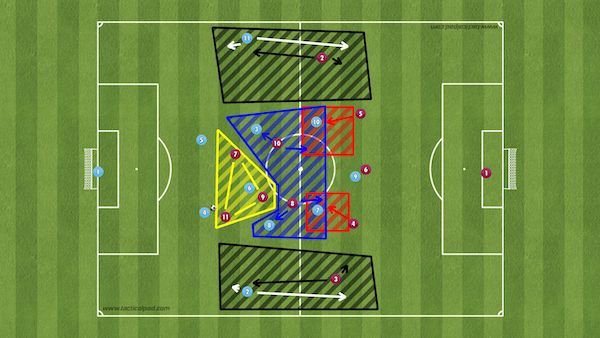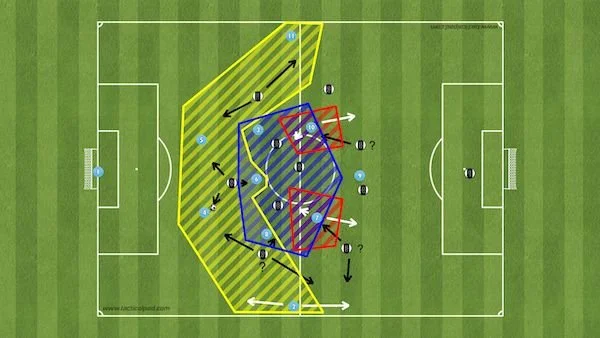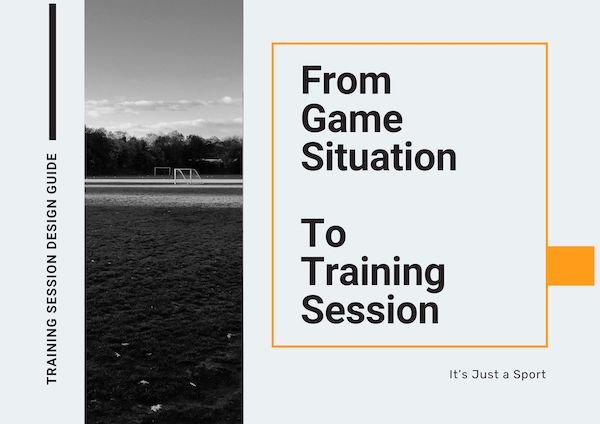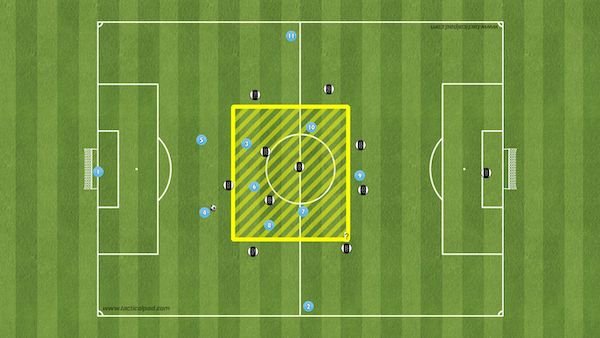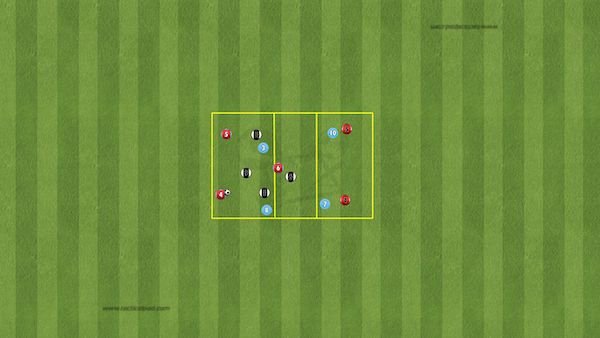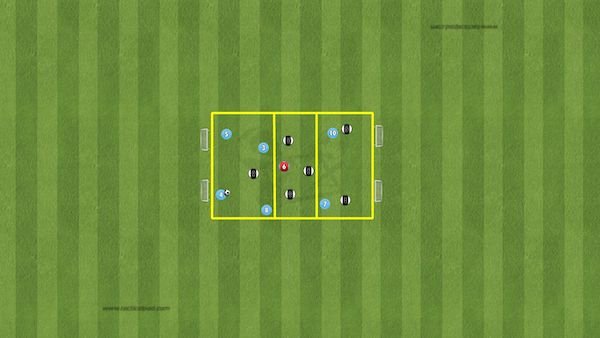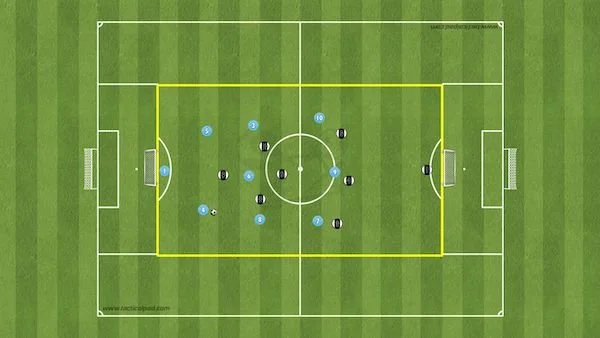Coaching Workflow: Manchester City
As a coach, I’m not satisfied with the traditional tactical match analysis I see on social media. I want to understand the football I see even further to be able to take it to the pitch. In order to apply my knowledge as a coach, I want to push myself and attempt to recreate training sessions based on what I observe in matches.
How would I help players bring to life the football necessary on match days?
To do this, this article is going to follow this structure:
Decipher the Game Model: What are the Playing Style Principles?
Discern the Game Plan: How are the principles being applied against certain opposition (Tactics)?
Devise the Game Prep: How would I help players better enact the Game Plan (Training)?
DECIPHER THE GAME MODEL
Watching Manchester City play it’s very clear their are two distinct moments in the attack:
Organized Build Up
Organized Creation of Scoring
The key distinction between the two moments is the objective. In the Organized Build-Up the objective is to progress the ball closer to their opposition’s goal. In the Organized Creation the objective is to create enough space and time to get a relatively unobstructed shot on goal.
Another obvious distinction is how the opposition are defending. In the Organized Build-Up, the opposition allows more space between lines whereas in the Organized Creation, the opposition minimizes the amount of space between lines as much as possible.
Lastly, one almost imperceptible distinction between the two moments is the functions City players take on in terms of Rest-Defense. Rest-Defense is how attacking players position themselves in possession to more quickly reorganize to recover the ball when they lose possession.
For example, in the Organized Creation the two center backs are much more narrow than in the Organized Build-Up to prevent the opposition from progressing and hopefully recovering the ball quickly.
Now that we have clarified two distinct moments in City’s attack, we are going to look at the Organized Build-Up in much more detail.
The first step is trying to decipher what the objective of City’s Organized Build-Up is. Of course, any conclusion I make in this article is simply an attempt to deduce it from what I have observed in matches.
It’s no secret that City love to play in the space between the opposition back line and midfield line. This is definitely a pattern we can see throughout all their matches. This leads me to believe that this space is vital to their approach no matter who the opposition is.
More specifically, City love the Half-Spaces. This is another definite pattern we can see throughout all their matches. This leads me to believe that Half-Spaces are also an essential piece to their Playing Style Principles.
Basically, it’s the spaces in front of the backline between outside backs and center backs.
Another pattern we can see over all of City’s matches is their desire to control those spaces by overloading the opposition’s midfield. They want to create numerical midfield overloads.
All of these factors are patterns in City’s Organized Build-Up no matter who the opposition from which we can conclude make up one of their Playing Style Team Principles.
Team Principles are guiding principles. They help guide behavior of ALL players on the team. It’s key that Team Principles allow for all players to contribute because as Martin Rafelt of Spielverlagerung says, “The best football is one that keeps all players active, both physically and mentally.”
What this means is that all players must feel they can contribute to the team principle at any given moment.
Bearing all of that in mind, we can formulate a Playing Style Team Principle which describes City’s unique manner of Building-Up:
City want to get the ball between opposition back line and midfield line, more specifically in the half-space, by creating midfield overloads usually forcing back line players to step up
With the Playing Style Team Principle formulated, we can now look at specific opposition’s attempt to prevent City from achieving their Playing Style Principle.
DISCERN THE GAME PLAN
We’re going to look at two specific opposition, Burnley and Newcastle.
First we’ll look at how each team attempted to defend City.
Let’s look at Burnley.
Their basic defensive structure was a back line of five, two defensive midfielders, and three players further up the pitch making up their front line. At times the wingers dropped into the midfield to cover wide areas.
From that defensive structure, there were some roles that made Burnley’s approach unique.
The front three players were often staggered to be better positioned to defend third man passes and to better defend angled passes. (Yellow)
The Burnley wingbacks were tasked to step up to defend high when City players received in wide areas. (Black)
The left center back and right center would step into the midfield to defend City’s beloved half-spaces. (Red)
The two defensive midfielders would step to Kovacic, Silva, or Rodri but also attempt to close down the gap between them and the backline when they were beaten behind. (Blue)
Newcastle attempted a different strategy.
Their basic defensive structure was a back line of four, three central midfielders who often changed roles, and three front line players (with the two wingers often coming back to the midfield).
From that defensive structure, there were some different defensive roles for each player.
Striker (Isak) had to create a cover shadow to prevent City’s center most midfielder (usually Rodri) from receiving the ball while also pressuring the center backs. (Yellow)
Left winger (Gordon) had the task to work with Left Back (Dan Burns) to make sure Walker was never unmarked, get pressure on Ruben Diaz, and the right sided defensive city midfielder. This often left the left the winger in moments of indecision. (Yellow)
The right winger (Almiron) had to cover Grealish (with Trippier) and pressure Gvardiol. (Yellow)
The left back (Dan Burns) and right center back had to step to the half-spacers to help the midfield three when needed. This also caused these two players lots of indecision about when to step and when to hold. (Red)
The three central midfielders attempted to cover five city players (Rodri, Akanji, Kovacic, Foden, and Alvarez) who were constantly rotating in different roles to draw players out. (Blue)
The more defensive central midfielder (Joelinton) had to cover the space in front of the back line and as well as stepping to City’s three supporting midfielders.
DISTILLING THE GAME MODEL TO GAME PLAN (THE BIG IDEAS)
As we know, City wanted to get the ball between opposition back line and midfield line, more specifically in the half-space by creating midfield overloads usually forcing back line player to decide to step up.
There was a big difference about how to get entry passes into those half-space players because of the way that they were set up. Against Burnley, City often had the center backs look diagonally across the pitch into the opposite side's half-space.
Against Newcastle, it was often a straight ball through gaps in the Newcastle midfield line.
One of the keys to success in both matches was the relationship of Half-Spacers (usually Foden and Alvarez) exploiting space in front of back line and Supporting Midfielders drawing opponents away from half-spaces.
Essentially, each role needed to recognize when they needed to draw opponents away from the backline and when they need to sit in the pockets created and exploit the space between midfield line and back line (in half-spaces). It’s a constant dance.
Another key was the rotation of supporting midfielders coming high to low to draw opponents away. They would start high up the pitch and come closer and closer to their own center backs to create a large space between midfield line and back line. If they didn’t receive the ball, they would rotate out allowing another player to come short. The objective was to drag their marks away from the half-spaces.
Once that occurred, the timing of the pass from the back line or Rodri to the half-space players was crucial. Too late and the center backs would step in and comfortably defend it. Too early and the player wouldn’t get into the half-space in time.
Although those points were clear examples of each player having an understanding what each other were doing and when. They were clearly ‘in sync’.
At a more individual level, the Half-Spacers had to decide when it was best to turn and when they had to play back. This involved having an awareness of the space and before receiving the ball knowing if they had pressure on their back or not.
Furthermore, the Half-Spacers had to be able to turn with the ball as quickly as possible to exploit space and run at the back line. Foden has an incredible capability of this. Alvarez is not as quick on the turn but is very comfortable with pressure on his back.
DEVISE THE GAME PREP
This is my favorite part of the coaching process; bringing to life the match in training.
The way that I do this is by taking the match scenario and adapting to fit the needs of training.
For example, in this case we are going to train the Organize Build-Up, and more specifically the timing and rotation withing the midfield overload.
So remember the Playing Style Principle: Get the ball between opposition back line and midfield line, more specifically in the half-space, by creating midfield overloads usually forcing back line players to step up.
If I wanted to create an activation game - one that could be used as an introduction to the general idea of this - I would make it bi-directional so it’s constantly in play and repeating the same scenario with the game.
First, I’d start with the match scenario I’d want to recreate.
Then make it bi-directional with the appropriate numbers, the right amount of opposition, and we might get to something like this:
The conditions are:
#4 and #5 stay in their zones, #6 can go anywhere.
If an attacking player receives it in the middle zone, they get two points.
You could restrict how many players can be within each zone.
The aim would be to provoke rotations of the midfield players in order to create space in the middle zone (half-space) and perfect the timing.
Another option would be to do something much more match-realistic by adding directionality.
It would look something like this:
The conditions would be similar to the previous activity but in this case it’s directional (blue towards the right and black towards the red).
In this activity it would be best to not restrict to zones to provoke creating and exploiting the space in the middle zone.
Lastly, here is a conditioned game that would look much like the match scenario I showed above but in smaller spaces and less players.
In this conditioned game, the blue team was the focus of the activity. They would have to create and exploit space through potential solution for the match (eg. versus Newcastle midfield rotations, coming from high to low, timing run into half-space, etc). Essentially, the defending team is set up like the opposition and the attacking must achieve their Playing Style Principle.
COACHING WORKFLOW
Everything I have covered in this article is a coach’s workflow. The coach must understand their own game model, then they analyze their opponent to understand how their team might have to play, and lastly recreate match scenarios so players are familiar with how the match might play out.
When a coach manages to execute this entire process flawlessly, they are a competent coach.

